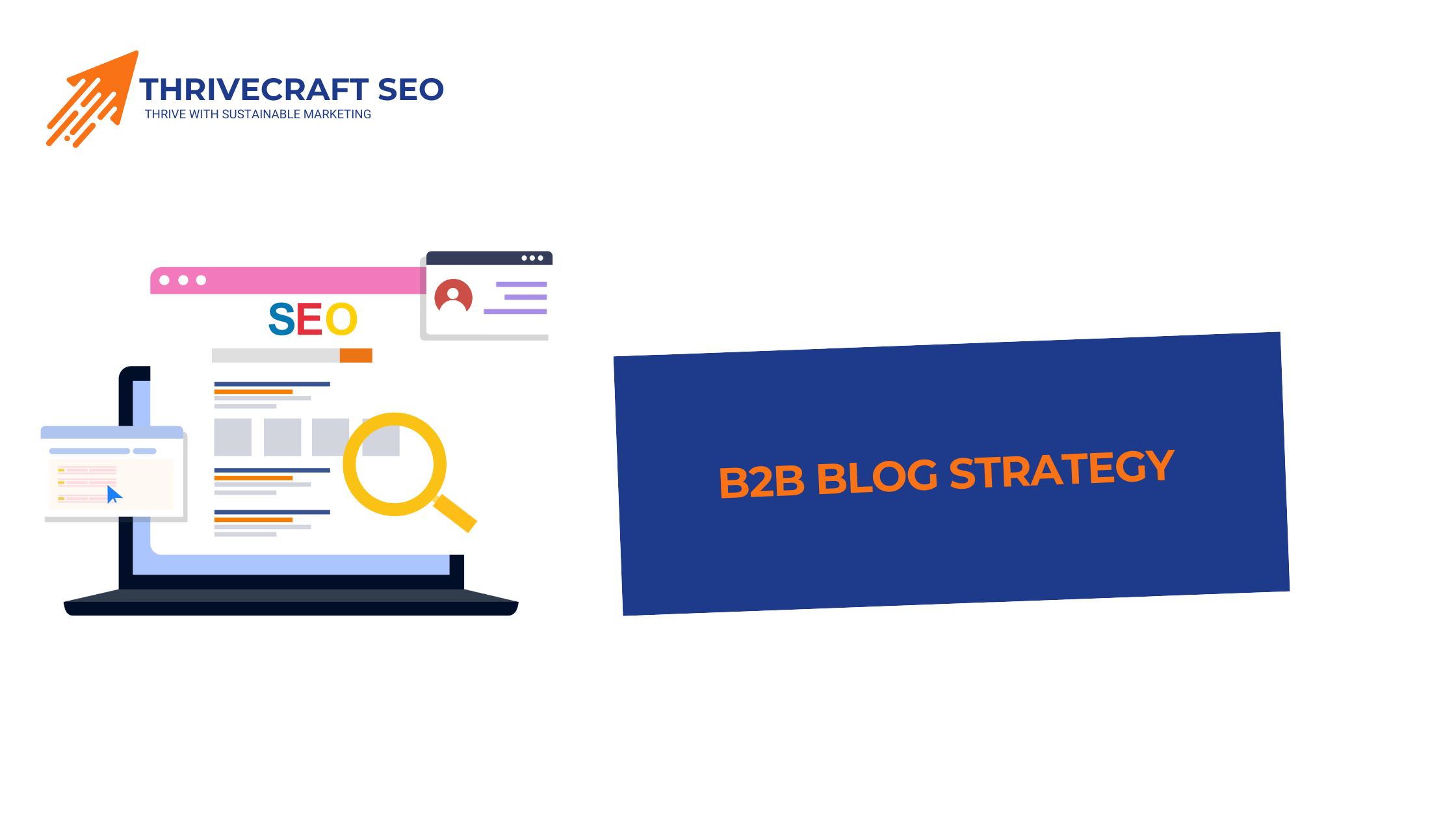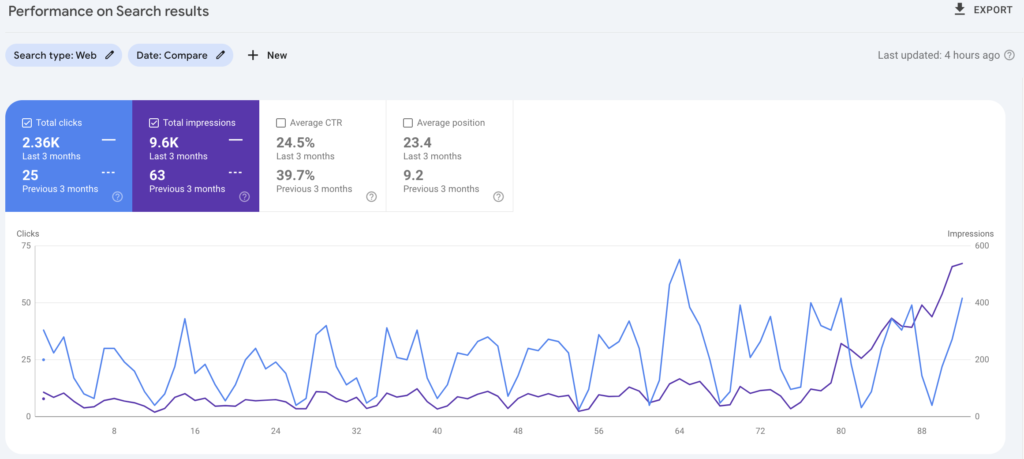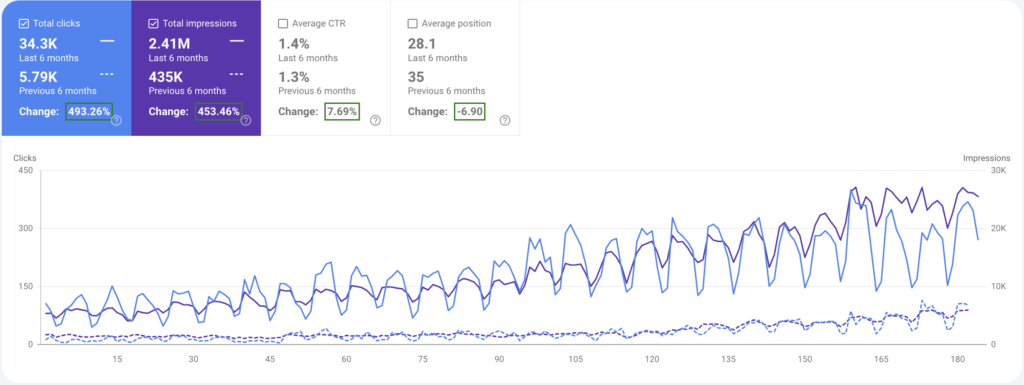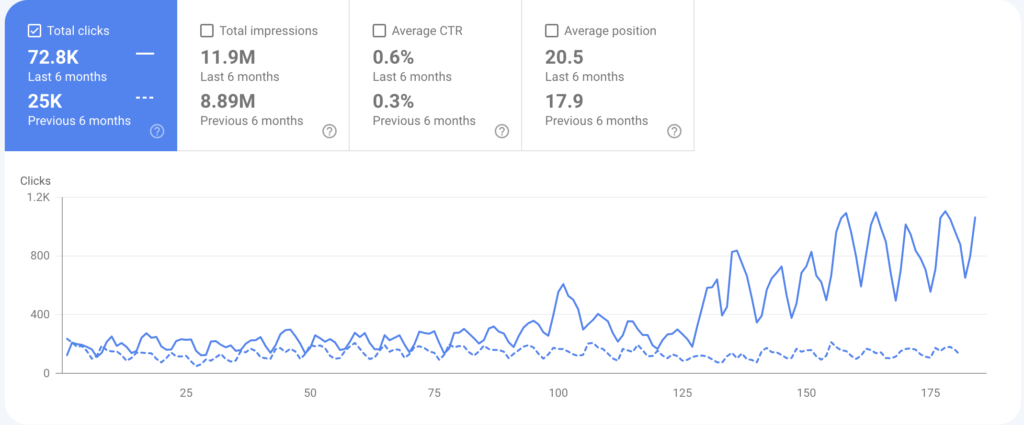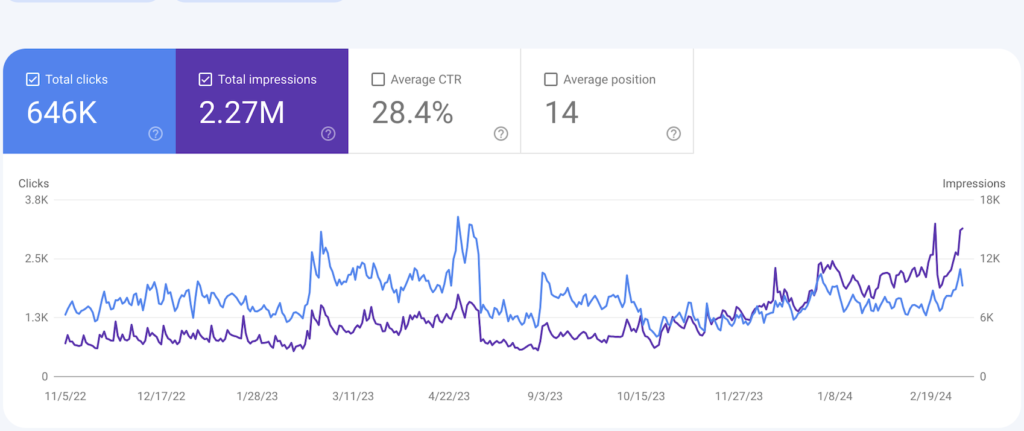Foundational component. It is the blog that is the core of every b2b marketing strategy. A solid b2b blog strategy helps you understand your audience’s pain points, needs, and content preferences. It builds authority, attracts high-quality leads, enhances search rankings, and increases reach.
According to a report from Master Blogging, websites that generate blogs get 67% more leads than those that do not. But creating a strategy that works is challenging. Imagine creating your first strategy and implementing it all, only to find that it didn’t work.
This is where ThriveCraft SEO can help you. Our proven experience helped hundred plus websites rank higher than their competitors. Most businesses post content aimlessly. Their content lacks SEO integration. We not only integrate SEO in the content, we create roadmap that addresses every stage of the funnel.
This way, your content reaches the right audience, which turns your warm readers into business opportunities. To know how all of this is going to work, Book a discovery to see if we are the right fit for your business OR Turn your warm leads into business opportunities
TL;DR- B2B Blog Strategy
If you are in a rush, read this and skim the blog instantly:
- Define Your Target Audience
- Identify the Problems
- Research Your Target Audience
- Ask Key Interview Questions
- Identify Key Components
- Create Personas
- Use a Buyer Persona Template
- Develop a Persona Story
- Compile Buyer Personas
- Share and refine
- Perform Keyword Research
- Optimize Your Blog for Conversions
- Promote Your Blog for Maximum Reach
- Track Metrics and Improve Performance
What is a B2B Blog Strategy?
The process of creating and distributing content that aligns with other businesses, provides valuable information to leads, and nurtures them to make a purchase via blogs is known as the b2b blog strategy.
The best b2b strategy educates readers, solves problems, and keeps them engaged all this creates a unique identity of that business. Overall, businesses that prioritize blogging have 13x more chances to get positive ROI in their marketing efforts.
Why is a B2B Blog Strategy Crucial?
B2B blog strategy is crucial because it is a part of content distribution and creation, which is aligned to
Businesses rather than consumers. Here are nine reasons that will give you a broader reason:
Lead Generation
B2B companies that generate blogs have 67% more leads than their competitors who do not.
Increases website traffic
Companies that prioritize blogging can see up to 55% more website visitors.
Boosts SEO
A company that supports SEO b2b blog strategy increases organic website traffic rankings through early-stage searches.
Influence on Purchase Decisions
71% of B2B buyers read blogs during their buying cycle
Establishes Authority
A company that publishes quality content that the audience finds useful shows expertise in industry-related topics and drives more traffic to a site, which increases domain authority.
This positions a brand as a leader in its industry on search engines.
Improves Brand Awareness
It establishes a brand’s blog as a source that can answer a prospect’s questions so businesses can improve brand awareness, increase SEO, and increase organic traffic.
Increases ROI
Marketing teams considering blogging are 13 times more likely to get a positive ROI.
Educates Potential Customers
Blog content educates readers on what’s happening in an industry, helps them solve a problem, and keeps them hooked through great writing as they travel along a marketing funnel.
Repurposes content for different channels
One blog post can give you several opportunits for reproducing content into various channels, such as newsletters, social media, and YouTube.
Steps to Create a B2B Blog Strategy
Define Your Target Audience
Identify your target audience by segmenting them by demographics, which include location, age, gender, and interests. Look at where your visitors are coming from, what keywords they use to find you, and highlight their desires and intent.
Before you create your audience personas, talk to consumers and potential target audiences, send emails, conduct user interviews, and run surveys and questionnaires.
Create detailed and fictional representations of your target audience based on collected information. Each audience persona should have a name, job title, background, goals, challenges, and a brief narrative that brings the persona to life.
The questions you ask to identify your audience personas depend on the level of detail you’re looking for. When you start, focus on basics such as age, gender, location, and income.
It is crucial to understand the pain points because it shapes value proposition, differentiates your offerings, builds trust and loyalty, improves customer experience, develops unique solutions, creates core connections, and tailors messaging.
Identify the Problems
If you want to identify their problems, identify pain points. To do that, gather customer feedback, analyze their data, research their needs, talk to your sales team to receive first-hand customer query knowledge, monitor your social media, observe your competitors, and use the four Fs framework.
Create detailed buyer personas that guide your content. Follow these eight routes to do so:
Research Your Target Audience
Conduct your target audience research via interviews, surveys, and data analysis. Interview current and potential customers, visit forums and blogs, and analyze industry and competitor data.
If you are already selling products, then interview or survey your existing happy customers. If you are not yet selling, aim to interview customers of products you feel you would be competing with.
Ask Key Interview Questions
Concentrate interview questions on the customer’s buying process. The one thing a buyer persona should make clear for your business is exactly how it will serve this person.
- Why did you buy our product?
- What alternatives did you choose us over and why?
- Where did you look for information when making this decision?
- Why did you buy this now, as opposed to earlier or later?
Identify Key Components
Look for common characteristics and group them to form the basis of your unique customer personas. Key components include demographics (age, gender, location), psychographics (interests, values, aspirations), pain points, goals, challenges, and preferred communication channels.
For B2B markets, job title, decision-making hierarchy, industry, company size, budget, and business priorities.
Create Personas
Develop a persona for each segment and assign a name, age, and face using a stock photo to make it more relatable. Additionally, goals, objectives, and psychographic information.
This includes values, interests, hobbies, lifestyle choices, behavioral characteristics that include buying patterns, preferred communication channels, information sources, challenges, and pain points shall be included.
Use a Buyer Persona Template
Employ a buyer persona template to save time and ensure you include the right information.
Key data points include name, age, language, location, education, income, relationship status, job, role in purchase decisions, biggest challenges, aspirations, online behavior, favorite brands, and content consumption preferences.
Develop a Persona Story
Give your persona a name, picture, and bio to help internalize them in your mind to create marketing communications that speak. Write a short story or vignette to make the person come alive.
Compile Buyer Personas
Gather your research and start looking for common characteristics. As you group those characteristics, you’ll have the basis of your unique customer personas.
For example, you might identify a core customer group as 40-year-old, professionally successful city-dwelling women with no kids and a passion for great restaurants. Name your buyer persona “High-Achiever Haley.”
Share and refine
Distribute the personas among your team members and stakeholders, encouraging feedback and being open to refining the personas as you gather more data and insights. Regularly review and revise your buyer personas, as your customers’ preferences change over time.
Perform Keyword Research
Use the best keyword research tools like Ahrefs, Moz keyword explorer, Google Keyword Planner, Semrush, and SpyFu.
To make the best use of keyword research tools identify the high-intent keyword tools to match buying intent. These keywords are intended to take a specific action. It could be purchasing, requesting a quote, or scheduling a service.
Build a Content Calendar
Create a content calendar to serve as a roadmap for content creation and distribution efforts. This will give you structure and guidance while ensuring every content aligns with overarching goals and messaging.
Write Content Briefs
A content brief is a detailed outline that guides content creators to produce content that aligns with your strategy and meets your business goals.
It acts as a blueprint, ensuring everyone involved understands the content’s purpose, target audience, key message, and technical requirements.
Additions for B2B Blog Content
Use Storytelling techniques to connect with your audience. It can create emotional connections, maintain audience engagement, and make presentations more memorable.
Sparklines, In media’s res, false start, petal structure, narrative arcs, emotional appeal, suspense and surprise, humor, empathetic storytelling, transformations tales, sensory storytelling, interactivity, relatable character, personal anecdotes, and early hooks are some of the best techniques to connect with your audience.
Use visuals for higher engagement. Some strategies you can start with are adding visuals, understanding visual preferences, using video content, employing infographics, using branded images, sharing attractive photos, Using GIFs, telling stories with pictures, interactive content, and carousel posts.
Perform a Content Gap Analysis
Content gap analysis helps to identify and fill gaps in your blog strategy.
Think about how you will define content calendar, analyze existing content, understand your audience needs, conduct competitive content analysis, analyze SERPs, prioritize gaps, make a strategy to fill those gaps, fin posts that are underperforming, use content gap analysis tools, and do all this frequently.
Follow all this to identify and fill those gaps.
Optimize Your Blog for Conversions
Use behavior-driven CTAs designed to align with users’ actions and behaviors on your website or app. Personalize CTAs based on user interactions to make them more relevant and effective.
Personalization, improved user experience, increasing conversion rate, increasing engagement, targeted marketing, data-driven insights, and enhancing customer journey is what the role of behavior-driven is.
Promote Your Blog for Maximum Reach
Use different channels to promote your blogs. Here are four of them you can start with:
Social Media
Optimize social media profiles, post engaging content, share link posts, run product ads, make use of user-generated content, and engage actively in group communities. This will give you attraction via social media.
Email Campaigns
Email list segmentation, compelling subject lines, valuable email content creation, email design and layout optimization, personalization, and automation are some ways your email campaigns can gain traction.
Partnership
Partner with other brands to reach each other’s audiences and introduce your content to new markets. Ensure that your audiences complement each other.
The cost-effectiveness of content collaboration over traditional advertising is that when resources are shared, there will be a better return on investment.
Influencer Marketing
Prioritize long-term partnerships to build trust and authenticity. A high percentage of brands opt for repeat collaborations with influencers. Develop an ambassador program where influencers regularly receive products, share updates, and promote special offers.
Track Metrics and Improve Performance
Use B2B SEO tools to measure conversion rates, qualified leads, and traffic growth to measure blog success. Here is how you can leverage three of them;
Conversion Rate
Measure your blog’s conversion rate by how many visitors on your site perform a desired action, such as subscribing to an e-newsletter or filling out a lead generation form. The conversion rate is the percentage of people who followed through and took the desired action.
Qualified Leads
Monitor KPIs that track leads and customers to determine blog performance.
Traffic Growth
Traffic growth tells you the total number of visits across all your blog content, which allows businesses to assess your site’s overall reach and popularity.
Use tools like Google analytics, Jetpack, Semrush, Google search console, buzzSumo, Chatbeat, Databox, alexrank, and Rank rager to optimize your blogs for better results.
Benefits of Outsourcing Blog Content Creation
When you outsource blog content creation, you will receive numerous benefits.
You can leverage specialized skills and produce high-quality content without the overhead costs of hiring full-time employees. Here are some of the key benefits:
Accessibility to skills and experience
You will gain access to professionals with expertise in various fields, such as SEO writing or graphics design. This way, you will get expert knowledge and skills to produce well-researched content for your audience.
Cost reduction
Content outsourcing is more cost-effective than in-house writers, as well as their ancillary benefits and workstation costs.
Saved time
Once you outsource, you have more time to focus on core activities like strategy and product development. Content creation outsourcing can lighten the workload and stress associated with it.
Consistency
A consistent flow of content aligned with the brand guidelines increases audience engagement.
Scalability
You can scale up or down the content volume according to the industry’s current needs.
Fresh Perspectives
You will get new ideas for the content strategy, which make your business stay innovative and competitive.
Improved SEO
It ensures content is optimized for search engines, increasing online visibility.
Wider audience reach
Professional writers publicize content in their blogs and networks, allowing the content to reach new targeted customers.
Flexibility
In contrast to employing an in-house writing staff, outsourcing is way more flexible as it allows the distribution of content-related tasks according to schedule.
Quality Assurance
You will get high-quality, error-free content that reflects positively on a brand. Reputable content creators should have quality control processes to ensure quality.
Frequently Asked Questions (FAQs):
How Outsourcing Can Free Up Internal Resources?
When you outsource, you free up your time, and reduce workload, and stress that is usually associated with content creation.
How do Keyword Research Tools Improve Blog Performance?
Keyword research tools identify relevant keywords, improve search engine rankings, help to understand competition, enhance content quality, and help to track performance.
What is Content Gap Analysis, and How Does it Benefit B2B Blogs?
A process to identify topics, keywords, or content that your website does not have but your competitor has is known as content analysis.
Content analysis improves search engine rankings, enhances content quality, increases engagement, helps generate leads, and helps gain a competitive edge; all this benefits businesses.
What Are the Best Ways to Drive Traffic to My Website?
SEO, content marketing, SMM, email marketing, guest blogging, and paid advertising are some of the best ways to drive traffic to your site.
Why is SEO Important for B2B Blogs?
SEO is essential because it increases visibility, targets traffic, builds brand authority, generates leads, is a cost-effective marketing method, improves user experience, and gives competitive advantages.
Conclusion
A B2B blog strategy is a well-thought-out content marketing plan that shows how a business uses blogging to attract qualified traffic, deliver value to the reader, outperform the competition, help meet marketing and business objectives, and continually improve performance.
It acts as a roadmap guiding key processes, such as content calendar configuration, content brief creation, frequency establishment, SEO optimization, conversion goals, and content promotion. A successful B2B blog strategy helps analyze your market to create posts that will attract more clients to your site.
However, blog strategy requires years of proven experience to make it work. Five blogs published with a refined strategy will outperform more than throwing zillions of blogs aimlessly on the site.
If you are looking for a custom blog strategy based on your business that is under budget, ThriveCraft SEO can help you. Our custom strategy has helped companies to reach up to 1.33 Million impressions in the span of the first six months.
Our organic link-building approach helps us ensure links that last long. Look for improvements. Highlight them for te next time. And make sure it aligns with our next plan.
We understand that 80% of the results comes from content and backlinks. This knowledge makes us focus on that area the most, which makes us create the most impact in the shortest time possible.
If you have any doubt regarding how we will create a custom strategy for your business, you can get it answered.
OR

